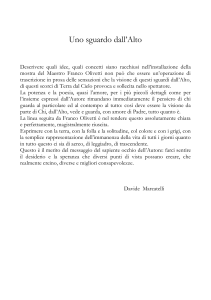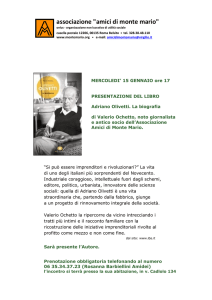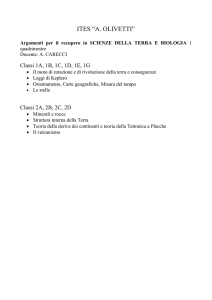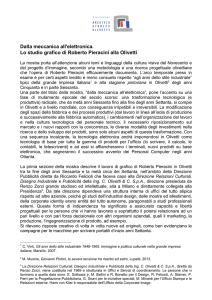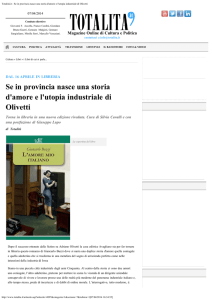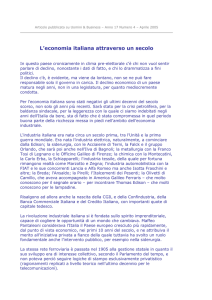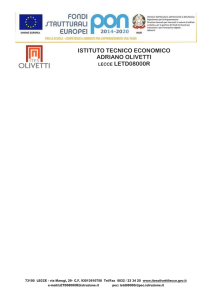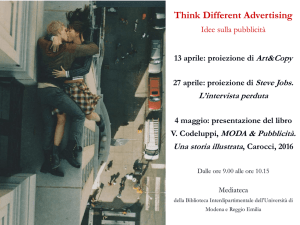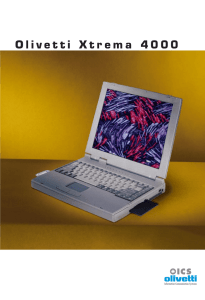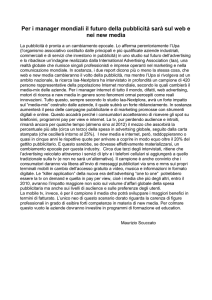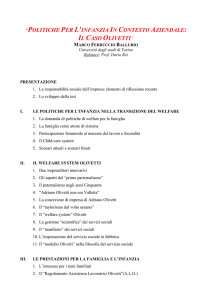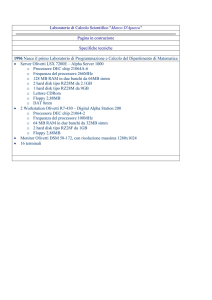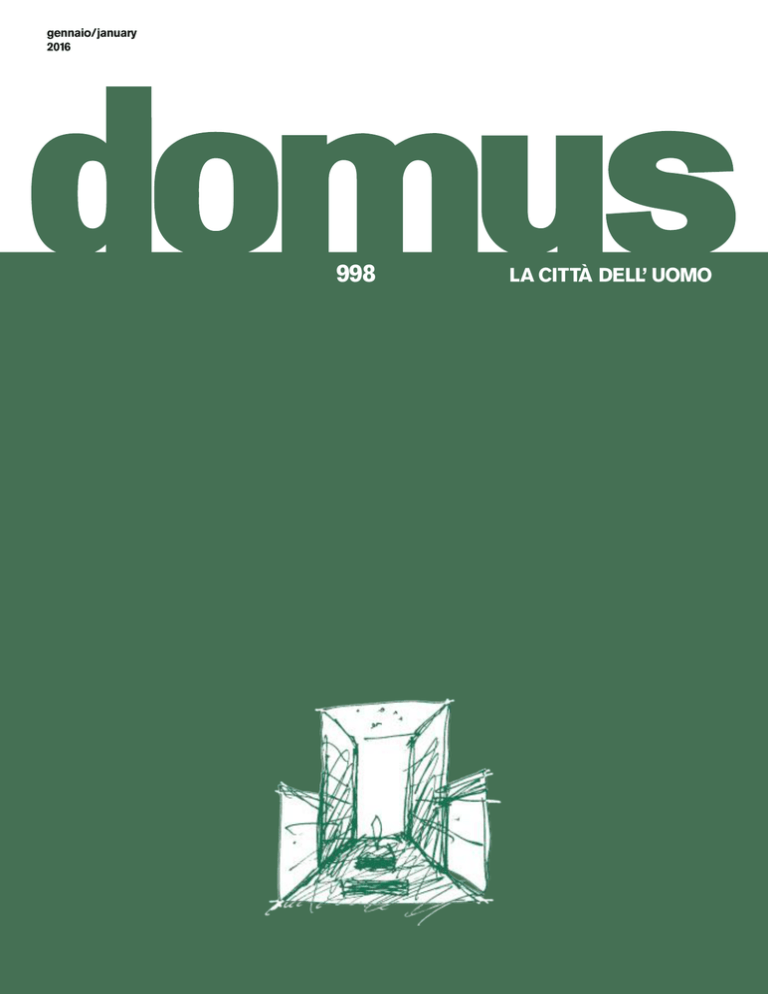
gennaio/january
2016
998
LA CITTÀ DELL’ UOMO
domus 998 Gennaio / January 2016
30 CORIANDOLI / CONFETTI
LE RESPONSABILITÀ DEL GRAFICO
Nel 1967, Giovanni Pintori pronunciò uno dei suoi rari
discorsi sul mestiere del grafico che deve “rafforzare certe
indispensabili basi di chiarezza, gusto e onestà informativa”.
Lo ripubblichiamo in occasione dell’uscita del volume, curato
da Marta Sironi, che riunisce il suo lavoro per Olivetti
© Archivio Paolo Pintori
In 1967, Giovanni Pintori gave a rare speech about the
graphic designer’s duty to “strengthen certain indispensable
foundations of clarity, taste and informational honesty”.
We republish it here on the occasion of a new book, edited by
Marta Sironi, the first overview of Pintori’s work for Olivetti
In questa pagina: a sinistra, copertina
della rivista Fortune, marzo 1953; sotto,
Giovanni Pintori negli uffici milanesi
di Olivetti, nel marzo 1966; in basso,
pubblicità della macchina per scrivere
Olivetti Tekne 3, 1966.
Pagina a fronte: in alto, pubblicità
editoriale della macchina per scrivere
Olivetti 22, composizione originale del
1959 (a sinistra); manifesto pubblicitario,
sempre per la Olivetti 22, del 1954
(a destra); al centro della pagina,
un disegno di Giovanni Pintori degli
anni Sessanta
Photo Ugo Mulas
Giovanni Pintori
Il testo è tratto da un discorso che
Giovanni Pintori ha tenuto nel 1967, in
occasione della presentazione della sua
personale alla Design Gallery di Tokyo.
Il testo integrale è pubblicato sul volume
Pintori (a sinistra) curato da Marta
Sironi con il progetto grafico di Marina
Del Cinque, Moleskine, Milano 2015.
• Taken from an address held by
© Archivio Paolo Pintori
Giovanni Pintori in 1967 for the
inauguration of an exhibition of his work
at the Design Gallery in Tokyo.
The full text was published by Moleskine
in the book Pintori (left) edited by Marta
Sironi, graphics by Marina Del Cinque,
Milan 2015.
Fin dalla fine degli studi ho avuto
un’opportunità meravigliosa: lavorare
sempre per un’industria e soltanto
per essa, dall’inizio della sua
espansione fino al raggiungimento
della sua importanza mondiale.
Considero quindi il mio lavoro come
un lungo e ininterrotto discorso,
rivolto per mio tramite da questa
industria ai suoi clienti e al pubblico
di tutto il mondo. Fui chiamato
personalmente a lavorare da Adriano
Olivetti, uno dei primi industriali
a comprendere l’importanza
della pubblicità e del design che
sempre volle dirigere di persona,
convinto che questi servizi fossero
fondamentali per un’industria
moderna. Una buona pubblicità non
si misura dalle cifre in denaro spese
per realizzarla. Facendo solo dei
confronti posso dire che un’industria
italiana di elettrodomestici che
fa una pubblicità molto anonima
e scadente, che non ha certo le
fabbriche e l’organizzazione nel
mondo della Olivetti, ha un budget
pubblicitario cinque volte maggiore
di quello nostro in Italia e spende
solo in Italia quasi il doppio di quello
che spendiamo noi in tutto il mondo.
Un’altra organizzazione, che produce
e vende generi alimentari, spende
per la sua pubblicità in Italia circa
dodici volte la cifra che spendiamo
noi in Italia. Io credo che una
pubblicità senza chiarezza e senza
coerenza, anche quando ha qualche
esempio isolato di buon design,
è destinata fatalmente a perdere
gran parte della sua efficacia nei
confronti del pubblico perché lo stile
di un’industria si afferma nella qualità
domus 998 Gennaio / January 2016
CORIANDOLI / CONFETTI 31
• Opposite page: top left, cover
© Archivio Paolo Pintori
© Archivio Paolo Pintori
© Associazione Archivio Storico Olivetti (AASO), Ivrea, Italy
of Fortune magazine, March 1953;
centre, Giovanni Pintori at work in the
Olivetti offices in Milan, March 1966;
bottom, ad for the Olivetti Tekne 3
typewriter, 1966.
This page: far left, editorial campaign for
the Olivetti 22 typewriter, a layout from
1959; near left: printed ad for the same
typewriter, 1954. Below: a drawing
by Pintori from the 1960s
sostanziale e formale dei suoi prodotti,
ma si presenta e si fa conoscere
nell’ispirazione attenta e unitaria del
suo messaggio al pubblico.
Vi sono esempi di industrie che hanno
contribuito in questo Dopoguerra a
creare per gli artisti grafici un mercato
di alto livello, incoraggiando nel
campo grafico una notevole selezione
creativa e, come vantaggiosa e
ragionevole contropartita, sono
riuscite a personalizzarsi agli occhi del
pubblico. Da questa constatazione è
nato il concetto di “Corporate Image”,
che è il biglietto da visita non scritto
con cui un’industria presenta se
stessa, prevalentemente attraverso
la produzione pubblicitaria e la
caratterizzazione formale dei prodotti
in un’immagine inconfondibile.
Io mi auguro che l’esempio offerto
dalle migliori industrie in Giappone
e in tutto il mondo possa suscitare
nel campo della pubblicità una più
attenta sensibilità da parte di tutti
gli altri committenti e contribuire al
rafforzamento di certe indispensabili
basi di chiarezza, di gusto e di onestà
informativa, senza le quali la pubblicità
è fatalmente destinata a declassarsi
in mistificazioni e a mortificare
e offendere la sensibilità dei suoi
destinatari.
La figura del grafico ha acquistato
negli ultimi anni una precisa
fisionomia da quando i manifesti
pubblicitari, con rare eccezioni,
non sono stati più firmati da pittori
generici adattatisi per esigenze
pratiche a un genere che veniva
considerato di sottopittura, bensì
da artisti impegnati esclusivamente
nel campo della pubblicità grafica,
a un livello di genere artistico
autonomo, nel quale gli uomini che
vi si dedicano devono impegnarsi
totalmente.
La diffusione internazionale della
stampa, del cinema, della televisione,
l’identità degli scopi e la rapidità
delle comunicazioni, hanno fatto
sì che le manifestazioni grafiche
moderne siano valide per ogni
parte del mondo. Così, sono scaduti
i nazionalismi e si sono svuotati
i luoghi comuni della grafica inglese
per gli inglesi o americana per gli
americani: artisti grafici di tutto
il mondo si scambiano esperienze e
informazioni in Giappone, in Europa
o in America, ovunque vediamo gli
stessi richiami grafici, gli stessi film,
le stesse riviste.
Anche la grafica, come la poesia
o la pittura, è inserita e contribuisce
alla vita e al progresso dei popoli e,
come genere artistico indipendente,
anch’essa è un momento della
cultura contemporanea: come tale
partecipa dei caratteri comuni agli
altri movimenti culturali. Nei confronti
della pittura, evidentemente, il
rapporto è più stretto: spesso
la grafica pubblicitaria riesce
a trasmettere a un pubblico
enormemente vasto le espressioni
più aggiornate del gusto pittorico,
facendo anche opera di educazione
e divulgazione del gusto moderno.
Il grafico al servizio di un’azienda
assume una grande responsabilità
e, come nel mio caso, deve
intervenire giornalmente anche
nella soluzione di vari problemi
che assorbono molto tempo e lo
impegnano seriamente, perché
proprio in questo genere di cose,
spicciole e varie, sono messe alla
prova la serietà della preparazione
e la chiarezza delle idee: occorre
prendere decisioni rapide e
responsabili, garantendo un buon
livello di esecuzione e di efficacia,
anche naturalmente tenendo conto
di quegli elementi obbligati che
sono sempre presenti nelle nostre
opere grafiche pubblicitarie, come
slogan, nomi o marchi di fabbrica,
simboli o fotografie. Tutti i giorni,
noi grafici, se saremo al passo con
il nostro tempo, dobbiamo scoprire
qualcosa di nuovo, spostare in
avanti una bandierina ideale che
segnerà la nostra nuova posizione:
questo è il lato più bello e anche più
impegnativo del nostro lavoro.
domus 998 Gennaio / January 2016
© Associazione Archivio Storico Olivetti (AASO), Ivrea, Italy
32 CORIANDOLI / CONFETTI
In questa pagina, sopra: disegno
per una pubblicità per Olivetti, 1960.
Pagina a fronte: in alto a sinistra,
pubblicità internazionale per Olivetti
Underwood, disegno originale, 1961; in
alto a destra, pubblicità della macchina
per scrivere Olivetti Linea 88, 1967;
in basso, i pannelli pubblicitari della
Olivetti Diaspron 82, montati (sopra)
e nella loro versione definitiva (sotto)
• This page, above: drawing for
THE RESPONSIBILITIES
OF A GRAPHIC DESIGNER
does, has an advertising budget for
Italy that is five times greater than
ours, and spends in Italy alone almost
double what we spend in the entire
world. In another instance, there is
a food producer and distributor that
spends on its advertising in Italy
about twelve times what we spend
on advertising in this country. I believe
an advertising campaign lacking
clarity and coherence, even when it
has a few instances of good design,
is fatally destined to lose a large part
of its effectiveness with the public,
because the style of a company is
expressed in the quality of substance
and form of its products. Then it also
needs to be presented and made
familiar by means of an attentive
and unitary message to the public.
There are examples of companies
that have contributed in this postwar
era to creating a high-quality market
for graphic artists. They encouraged
healthy competition in the field of
graphic design. The advantageous
and reasonable compensation
received by these companies was that
they succeeded in making themselves
Immediately upon graduation, I had
the wonderful opportunity of working
for one single company only, from
the beginning of its expansion to its
achievement of worldwide importance.
So I consider my work to be a long
and uninterrupted conversation
held, through my mediation, by this
company with its customers and the
public at large. I was appointed by
Adriano Olivetti personally, one of the
first industrialists to understand the
importance of advertising and design,
which he always wished to direct in
person, convinced as he was that
these services were of fundamental
importance to a modern company.
A good advertising campaign is not
measured by the amount of money
spent in creating it. Just by making
comparisons, I can tell you that an
Italian manufacturer of household
appliances who makes terribly facile
second-rate advertisements and
who does not have the factories and
worldwide organisation that Olivetti
an Olivetti ad, 1960. Opposite page: top
left, original drawing for the international
campaign for the Olivetti Underwood
typewriter, 1961; top right, advertisement
for the Olivetti Linea 88 typewriter, 1967;
bottom, advertising panels for the
Olivetti Diaspron 82, mounted (above)
and in their final version (below)
identifiable in the eyes of the public.
This realisation led to the concept of
corporate image, meaning the nonprinted business card by which the
company presents itself, prevalently
through advertising and by moulding
the formal characterisation of its
products into an unmistakable image.
I hope that the example set by the best
industries in Japan and the world over
can generate in the field of advertising
an enhanced sensibility on the part
of all the other entrepreneurs. I hope
it contributes to the strengthening
of certain indispensable foundations
of clarity, taste and informational
honesty, without which advertising is
fatally destined to degenerate into
mystification, and will annoy and
offend the sensitivity of its audience.
In recent years, the profession of
graphic designer has acquired a
precise identity. This commenced
being so when advertising posters,
with rare exceptions, stopped being
created by generic painters adapting
themselves for practical reasons to a
type of painting deemed inferior. They
began being made by artists engaged
exclusively in the field of advertising
as an artistic category in its own
right, where those dedicated to the
discipline must be totally committed.
The international dissemination of
the press, cinema and television;
the identity of the aspirations; and
the swiftness of communication
have all made the manifestations of
modern graphic design become valid
for every part of the world. This has
brought the receding of nationalistic
typecasting, the dwindling of
stereotypes in British graphic design
for the British, and American graphics
for the Americans. Graphic artists the
world over exchange experience and
information in Japan, in Europe or in
America. Everywhere we turn we see
the same graphic allusions, the same
films, the same magazines. Graphic
art, like poetry and painting, is part of
life and contributes to it. It promotes
the progress of humanity, and as an
element of contemporary culture, it
shares common features with other
cultural movements. Compared to
painting, obviously, the relationship is
closer: graphic design in advertising
domus 998 Gennaio / January 2016
often succeeds in transmitting the
most up-to-date expressions of
pictorial taste to a vast audience, even
functioning as a means of education
and popularisation of modern tastes.
The graphic artist in the service of a
company takes on great responsibility
and, as in my own case, must engage
daily in the solving of diverse types
of problems that require considerable
time and serious effort. Precisely
the sundry minor details put one’s
commitment and clarity of ideas to
the test. One is called upon to make
quick and responsible decisions that
guarantee a high level of execution
and effectiveness. Naturally, one
also needs to take into account the
requisite elements that are always
present in all our advertising designs,
such as slogans, names, trademarks,
symbols and photographs. If we as
graphic artists wish to keep abreast
of the times, we must come up with
something new every day, advance
the flag of our ideals a few more steps
to leave the mark of our new position.
This is the best part of our job, and
the most demanding.
© Archivio Paolo Pintori
© Associazione Archivio Storico Olivetti (AASO), Ivrea, Italy
© Archivio Paolo Pintori
CORIANDOLI / CONFETTI 33
domus 998 Gennaio / January 2016
© Archivio Paolo Pintori
34 CORIANDOLI / CONFETTI
In questa pagina, sopra: composizione
originale per la pubblicità della macchina
per scrivere Olivetti Diaspron 82, 1959.
Le forme e i colori impiegati davano
l’idea del funzionamento e delle modalità
di utilizzo di una macchina per scrivere
• This page, above: advertisement layout
for the Olivetti Diaspron 82 typewriter,
1959. The shapes and colours are
a reference to the functioning and
use of a typewriter

